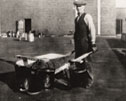The December 2010 meeting of ASTM International Committee D08 on Roofing and Waterproofing had the potential to bring about meaningful improvement to the U.S. product standard for TPO membranes. However, the meeting ended without a consensus, no change to the TPO product standard and no new guidance for users of TPO membranes.
ASTM D6878
The U.S. product standard for TPO membranes is ASTM D6878, "Standard Specification for Thermoplastic Based Sheet Roofing."
It originally was published in 2003 and arguable, is one of the least stringent product standards in the roofing industry.
NRCA has performed laboratory testing on TPO membrane sheets that have reached the end of their service lives and found the sheets' physical properties still pass the standard's minimum requirements.
In 2006, ASTM D6878's accelerated weathering test was improved by doubling the test's radiant exposure from 5,040 kJ/m2 to 10,090 kJ/m2.
During the past several years, heat exposure-related problems with TPO membranes have been identified as concerns with some installations.
Heat aging
During Committee D08's December 2009 meeting, the ASTM International representative from Carlisle SynTec Inc., Carlisle, Pa., submitted a proposal to increase ASTM D6878's heat-aging test from 240 F for 28 days to 275 F for 56 days. The proposal recognized ASTM D6878's requirements for heat aging originally were set too low and all material currently on the market likely would easily surpass the standard's original heat-aging level.
Most roof systems never will experience surface temperatures of 240 F or 275 F. High-temperature aging of single-ply membranes for defined time periods is used in laboratory testing to determine membranes' probable aging mechanisms. For TPO membranes using the 240 F currently specified in ASTM D6878, the time to test failure using visual examination can exceed one year in the laboratory. Most manufacturers consider this too long for practical purposes and, therefore, prefer using a higher temperature for a shorter period of time.
At the committee's June 2010 meeting and a follow-up meeting held in October 2010, additional laboratory data was presented to substantiate the proposed increase and agreement was reached to ballot the proposed increase to the heat-aging test.
The increase was balloted during ASTM International's November 2010 ballot period. Seventy-four ASTM International committee members voted in favor of increasing ASTM D6878's heat-aging requirement; three members opposed it; and 119 members abstained.
At the December 2010 meeting, the committee reviewed the ballot item and negative votes received. Two negative voters withdrew their votes based upon resolution of the remaining negative vote. The remaining negative voter cited the proposed 275 F heat-aging temperature was too high and could eliminate the use of hindered amine thermal stabilizers, which some manufacturers use to stabilize the polypropylene in TPO membranes.
The remaining negative voter was found to be persuasive by a split vote. As a result, the proposed revision failed, and ASTM D6878 remains unchanged.
What's next?
The task force responsible for maintaining ASTM D6878 is undertaking a round robin test program to develop additional data on varying temperature and time heat-aging relationships. The test data likely will not be available for a year or more. As a result, realistic and practical heat-aging requirements probably will not be added to ASTM D6878 within the next 18 months or longer.
In the meantime, the roofing industry is left with a product standard acknowledged to be significantly less stringent than many would like. During the coming months, I expect some TPO membrane suppliers will begin to promote how much their products exceed ASTM D6878.
Mark S. Graham is NRCA's associate executive director of technical services.



